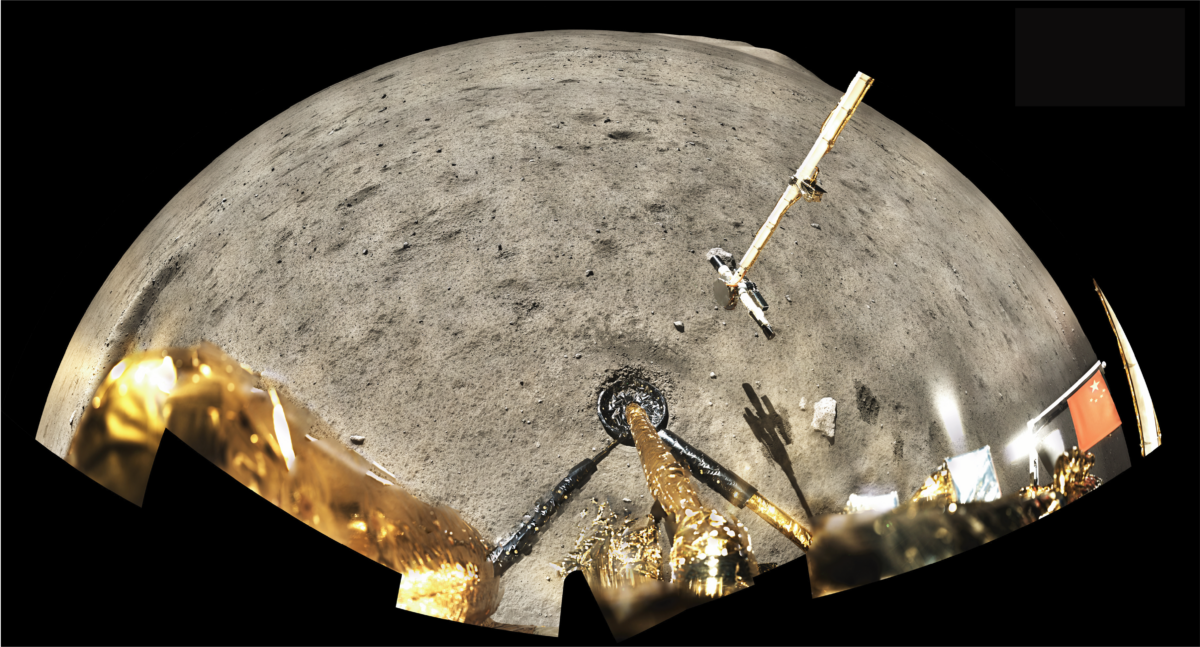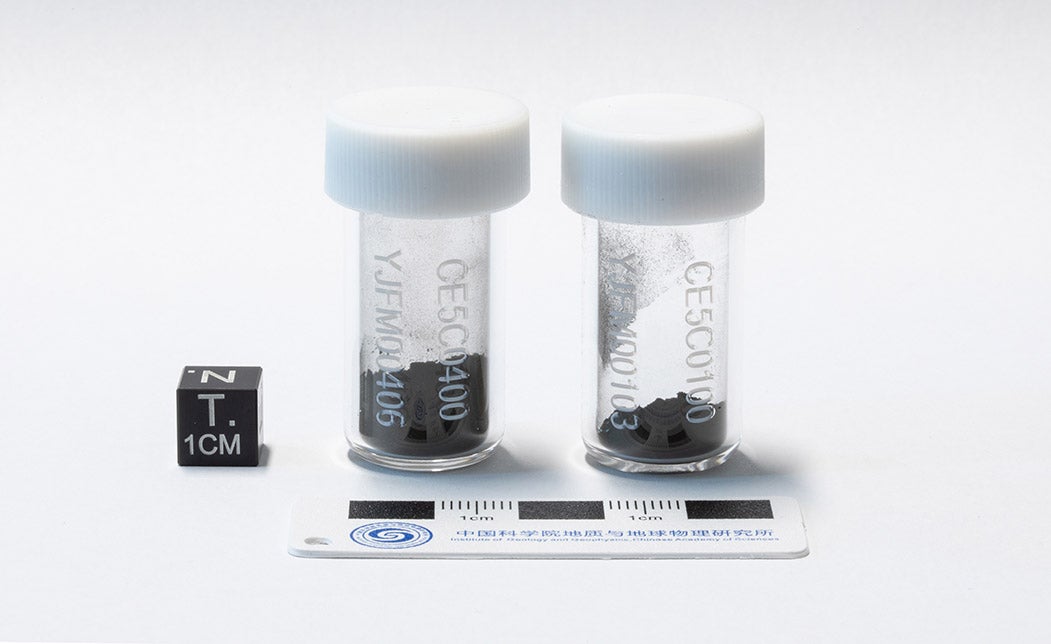
Chang’e 5 returned a panorama of the surrounding territory to assist in sample site selection. Credit: Chinese National Space Administration
Chinese researchers have reported evidence that the Moon was volcanically active just 125 million years ago — a geologic blink of an eye — a finding that has the potential to rewrite lunar history.
The results come from an analysis of lunar samples returned over three years ago by the Chang’e 5 mission, and upend previous assumptions that the world has been volcanically dead for a billion years.
The paper, authored by Bi-Wen Wang from the Institute of Geology and Geophysics at the Chinese Academy of Sciences in Beijing and his associates, was published Sept. 6 in the journal Science.
‘A needle in a haystack’
China’s Chang’e 5 lunar sample return mission launched on Nov. 23, 2020, and landed in the northern region of Oceanus Procellarum (Ocean of Storms) on Dec. 1, 2020. After recovering 3.82 pounds (1,731 grams) of lunar soil, including a core sample from 3 feet (1 meter) below the surface, the probe returned to Earth, landing in Outer Mongolia on Dec. 16, 2020. The craft returned the first lunar samples obtained since the Russian Luna 24 mission in 1976, and from a region farther north than any samples returned by either the Luna or Apollo missions.
In the new work, Wang and his associates meticulously examined four samples to separate about 3,000 glass beads ranging between 20 to 400 microns in size (0.0008 to 0.016 inch) recovered from the lunar soil and core sample. Identifying and handling the tiny glass particles required microscopic assistance. Analysis of the samples was accomplished with advanced techniques like analysis of electron backscatter, using an electron probe microanalyzer, and secondary ion mass spectrometry.
The majority of the beads were classified as impact-generated glass — created by the extreme heat of a meteor or asteroid impact. However, three of the beads were identified as volcanic in origin through their chemical composition and sulfur isotopes. The Chang’e 5 volcanic glass also had an elemental makeup that closely matches volcanic glass recovered by Apollo astronauts.
More significant was uranium-lead dating that showed the three volcanic glass beads were only 123 million years old, give or take 15 million years. The high abundance of thorium and rare Earth elements further suggested the recent volcanism was related to heat-generating elements in the lunar mantle.
The young age of the volcanic glass is a surprise, and the implication that the Moon was volcanically active just 125 million years ago is a stunning finding. 125 million years is just 2.5 percent of the 4.6-billion-year lifetime of the Moon. To find volcanism that late in the lunar timeline implies the Moon has been volcanically active for essentially its entire existence. Indeed, the Chang’e 5 results show volcanism was active on the Moon when the dinosaurs roamed the Earth.
The degree of difficulty in isolating and identifying three volcanic glass beads in a collection of 3,000 impact-generated beads was recognized in a commentary written by Yuri Amelin and Qing-Zhu Yin and published in the same issue of Science. They noted “the effort … put into finding the volcanic “needle” in the impact-generated “haystack” has paid off”.

A new lunar timeline
The new lunar volcanic timeline datapoint provided by analysis of the Chang’e 5 samples sheds exciting new light on the question of how long the Moon has been volcanically active.
The idea that the early Moon, shortly after its creation about 4.6 billion years ago, was molten and covered with a global magma ocean has received increased support from recent findings by India’s Pragyan lunar rover that roved the south polar region a year ago. However, the now-accepted global magma ocean and true volcanic activity on the Moon are two different geologic events. A perplexing question remained: How long has the Moon been volcanically active?
Analysis of previously returned lunar samples implies volcanic activity as long as 4.4 billion years ago. Even a naked-eye view of the Moon reveals evidence of ancient volcanism. The very face of the “man in the Moon” was formed by dark volcanic basalt plains lying within the low-lying impact basins. Planetary scientists now think is these sheets of basalt were deposited during a billion-year period of high volcanic activity between three and 3.8 billion years ago.
Additionally, the Moon has been assumed to be volcanically inactive for the past billion years. However, astronomers have found tantalizing clues of even more recent volcanism in the form of irregular mare patches, or IMPs, that have crater counts suggesting an age of less than 100 million years, and ash deposits around volcanic vents such as those around the inner perimeter of Alphonsus crater. Now, the analysis of the Chang’e 5 samples recovered from northern Oceanus Procellarum provides laboratory evidence that volcanic activity was present on the Moon in geologically recent times.
The Moon, being smaller than Earth, necessarily cooled faster after its formation than did the Earth. But the Chang’e 5 analysis shows the Moon may not be that different from Earth, which remains volcanically active.
This raises the question of whether the Moon is still producing magma today. Can internal radioactive elements still provide enough heat for magma chambers to still exist deep within the Moon’s mantle? Modeling studies will be needed to provide insight to this question.
After the gush of mid-20th century lunar exploration, the Moon gives up its secrets slowly in the 21st century, but the fascinating 125-million-year-old volcanic glass recovered by Chang’e 5 provides direction for future geological study of the Moon.
Robert Reeves has studied the Moon since the Apollo era, and his new book Photographic Atlas of the Moon was released by Firefly Books on Sept. 1.

